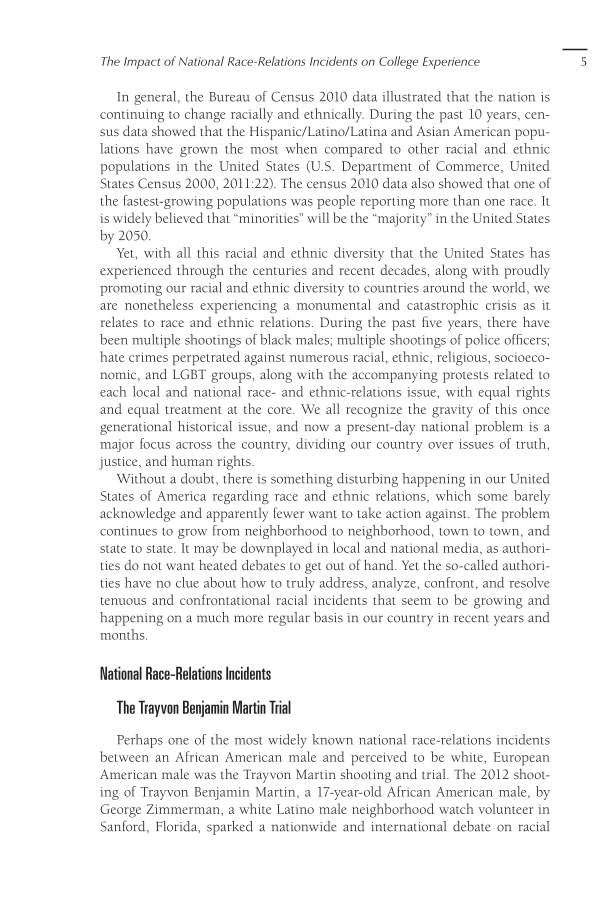The Impact of National Race-Relations Incidents on College Experience 5 In general, the Bureau of Census 2010 data illustrated that the nation is continuing to change racially and ethnically. During the past 10 years, cen- sus data showed that the Hispanic/Latino/Latina and Asian American popu- lations have grown the most when compared to other racial and ethnic populations in the United States (U.S. Department of Commerce, United States Census 2000, 2011:22). The census 2010 data also showed that one of the fastest-growing populations was people reporting more than one race. It is widely believed that “minorities” will be the “majority” in the United States by 2050. Yet, with all this racial and ethnic diversity that the United States has experienced through the centuries and recent decades, along with proudly promoting our racial and ethnic diversity to countries around the world, we are nonetheless experiencing a monumental and catastrophic crisis as it relates to race and ethnic relations. During the past five years, there have been multiple shootings of black males multiple shootings of police officers hate crimes perpetrated against numerous racial, ethnic, religious, socioeco- nomic, and LGBT groups, along with the accompanying protests related to each local and national race- and ethnic-relations issue, with equal rights and equal treatment at the core. We all recognize the gravity of this once generational historical issue, and now a present-day national problem is a major focus across the country, dividing our country over issues of truth, justice, and human rights. Without a doubt, there is something disturbing happening in our United States of America regarding race and ethnic relations, which some barely acknowledge and apparently fewer want to take action against. The problem continues to grow from neighborhood to neighborhood, town to town, and state to state. It may be downplayed in local and national media, as authori- ties do not want heated debates to get out of hand. Yet the so-called authori- ties have no clue about how to truly address, analyze, confront, and resolve tenuous and confrontational racial incidents that seem to be growing and happening on a much more regular basis in our country in recent years and months. National Race-Relations Incidents The Trayvon Benjamin Martin Trial Perhaps one of the most widely known national race-relations incidents between an African American male and perceived to be white, European American male was the Trayvon Martin shooting and trial. The 2012 shoot- ing of Trayvon Benjamin Martin, a 17-year-old African American male, by George Zimmerman, a white Latino male neighborhood watch volunteer in Sanford, Florida, sparked a nationwide and international debate on racial
Document Details My Account Print multiple pages
Print
You have printed 0 times in the last 24 hours.
Your print count will reset on at .
You may print 0 more time(s) before then.
You may print a maximum of 0 pages at a time.






































































































































































































































